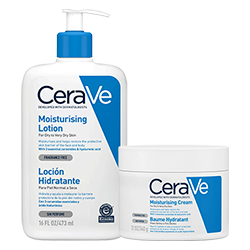Skin care for Diabetic skin management
Controlling blood-sugar levels is a top priority when living with diabetes, but it’s important to be diligent about skin care to help avoid the many side effects this chronic condition can have on the skin as well. Caring for your skin begins in the shower or bath, and it’s best to keep water at a warm (not hot) temperature. Afterwards, gently pat the skin dry (rather than rubbing) and pay special attention to areas of the body that can trap moisture, such as under the arms and breasts, the groin area and between the toes. This is also the perfect time to check your body for potential problems like especially dry, red or sore spots. It’s also important that you moisturize immediately after bathing5
Skin care for diabetic skin management consists of a handful of products, and it’s best to limit the number you use in order to avoid potential irritation. There are a variety of products that are specifically formulated to address dryness, which is an issue associated with diabetes. A gentle, body cleanser and moisturizing cream are the basics,5 to keep diabetic dry skin comfortable. If you’re not sure which products you should use, ask your physician or dermatologist for recommendations.
Always keep skin moisturized
In addition to using a cream after bathing, it’s best to apply often throughout the day as well to keep skin moisturized. The hands are especially prone to dryness, so be sure to apply moisturizer regularly, especially after washing. Keep a bottle or tube next to the sink so you don’t forget to use it.
Don’t forget your feet
Diabetes can lead to nerve damage and numbness in the feet, so it’s imperative to check your feet daily for any blisters or cuts you may not feel. Even the smallest injury can be prone to infection due to poor circulation that can compromise healing.6 A moisturising cream is helpful for keeping this problem-prone area moisturized—but avoid applying between your toes, as this is a common spot for fungal infections.4
- https://www.ncbi.nlm.nih.gov/pmc/articles/PMC3658433/
- Coderch, L., López, O., de la Maza, A. et al. Am J Clin Dermatol (2003) 4: 107.
- Baumann, L. (2015) Cosmeceuticals and Cosmetic Ingredients (pp.84-86). New York: McGraw-Hill Medical
- https://www.diabetes.org/diabetes/complications/skin-complications
- https://my.clevelandclinic.org/health/articles/12176-diabetes-skin-conditions
- https://www.diabetes.org/diabetes/complications/foot-complications
Remarks: This general information is not intended to diagnose any medical condition or to replace your healthcare professional. In cause of any doubt about your skin condition or cosmetic and/or skincare products, consult medical doctors and/or dermatologist advice prior use.


